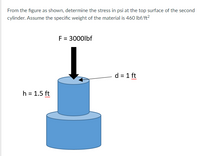
Elements Of Electromagnetics
7th Edition
ISBN: 9780190698614
Author: Sadiku, Matthew N. O.
Publisher: Oxford University Press
expand_more
expand_more
format_list_bulleted
Concept explainers
Question

Transcribed Image Text:From the figure as shown, determine the stress in psi at the top surface of the second
cylinder. Assume the specific weight of the material is 460 Ibf/ft?
F = 3000lbf
d = 1 ft
ww
h = 1.5 ft
ww
Expert Solution
This question has been solved!
Explore an expertly crafted, step-by-step solution for a thorough understanding of key concepts.
This is a popular solution
Trending nowThis is a popular solution!
Step by stepSolved in 3 steps with 3 images

Knowledge Booster
Learn more about
Need a deep-dive on the concept behind this application? Look no further. Learn more about this topic, mechanical-engineering and related others by exploring similar questions and additional content below.Similar questions
- Three metal rods are firmly attached to the walls and the middle rigid plate. Rod AB is made from stainless steel and rods CD and EF are made from 2014-T6 aluminum. If a balanced load is applied to the rigid plate, determine what the stresses are in the rods. Follow the sign convention that tensile stress is positive and compressive stress is negative. The parameter values are listed in the table above the figure. parameter value units L. 450 mm L2 300 mm d₁ 40 mm d2 30 mm P 40 KN L1 d₁ P B CC 030 BY NO SA 2021 Cathy Zupke P L2 D U MPa MPa The stress in AB σAB= The stress in CD and EF: σCD = σEF= E Farrow_forward7m 4 m 4m 4 m 4m 150 kN 100KN 120KN Determine the normal stress in member BC if the section is circular having an outside diameter of 70mm w/ a thickness of 5mm and indicate if the member is in Compression or Tension.arrow_forwardi need the answer quicklyarrow_forward
- That answer to this question is P=5.83kN. I just need help getting to it. Thank you in advancearrow_forward-8 in.- -8 in.- (a) (b) Which of the following best explains why cylinder (b) has a higher longitudinal stress in its walls compared to cylinder (a)? Assume the gauge pressure of the fluid inside the cylinder is non-zero. O Cylinder (b) is supported at two locations Cylinder (a) is not free to deform in its longitudinal direction The vertical (longitudinal) pressure in cylinder (a) is transferred directly to the [bottom] support, bypassing the cylinder walls None of the above the longitudinal stress for both cylinders is the samearrow_forwardAssemble a pair of parts A and B with serrated teeth as shown in the figure on the right.A compressive load of 24 kN is acting on the combined structure.The compressive load is transmitted by the three meshing teethTo. Shear stress and compressive stress (contact) generated in the tooth at this timeFind each tactile stress.arrow_forward
- Determine the resulting maximum value of the normal stress. Specify the orientation of the plane on which these maximum values occur. **The answer is tensile stress is 0 ksi at 90 degrees. **The answer is compressive stress is 7 ksi at 0 degrees. Can you explain how that is? This was my thought process: I know that tensile would be zero because the force P is actually going inwards and not outwards. I know that means that there would be a compressive force. I am confused on the angles, how is a tensile force going 90 degress if there technically is no force in the tensile direction. And how is there a compressive force at 90 degrees if there is a stress? thank you!arrow_forwardPlease full solution with the drawing. Big and clear handwritingarrow_forward
arrow_back_ios
arrow_forward_ios
Recommended textbooks for you
 Elements Of ElectromagneticsMechanical EngineeringISBN:9780190698614Author:Sadiku, Matthew N. O.Publisher:Oxford University Press
Elements Of ElectromagneticsMechanical EngineeringISBN:9780190698614Author:Sadiku, Matthew N. O.Publisher:Oxford University Press Mechanics of Materials (10th Edition)Mechanical EngineeringISBN:9780134319650Author:Russell C. HibbelerPublisher:PEARSON
Mechanics of Materials (10th Edition)Mechanical EngineeringISBN:9780134319650Author:Russell C. HibbelerPublisher:PEARSON Thermodynamics: An Engineering ApproachMechanical EngineeringISBN:9781259822674Author:Yunus A. Cengel Dr., Michael A. BolesPublisher:McGraw-Hill Education
Thermodynamics: An Engineering ApproachMechanical EngineeringISBN:9781259822674Author:Yunus A. Cengel Dr., Michael A. BolesPublisher:McGraw-Hill Education Control Systems EngineeringMechanical EngineeringISBN:9781118170519Author:Norman S. NisePublisher:WILEY
Control Systems EngineeringMechanical EngineeringISBN:9781118170519Author:Norman S. NisePublisher:WILEY Mechanics of Materials (MindTap Course List)Mechanical EngineeringISBN:9781337093347Author:Barry J. Goodno, James M. GerePublisher:Cengage Learning
Mechanics of Materials (MindTap Course List)Mechanical EngineeringISBN:9781337093347Author:Barry J. Goodno, James M. GerePublisher:Cengage Learning Engineering Mechanics: StaticsMechanical EngineeringISBN:9781118807330Author:James L. Meriam, L. G. Kraige, J. N. BoltonPublisher:WILEY
Engineering Mechanics: StaticsMechanical EngineeringISBN:9781118807330Author:James L. Meriam, L. G. Kraige, J. N. BoltonPublisher:WILEY

Elements Of Electromagnetics
Mechanical Engineering
ISBN:9780190698614
Author:Sadiku, Matthew N. O.
Publisher:Oxford University Press

Mechanics of Materials (10th Edition)
Mechanical Engineering
ISBN:9780134319650
Author:Russell C. Hibbeler
Publisher:PEARSON

Thermodynamics: An Engineering Approach
Mechanical Engineering
ISBN:9781259822674
Author:Yunus A. Cengel Dr., Michael A. Boles
Publisher:McGraw-Hill Education

Control Systems Engineering
Mechanical Engineering
ISBN:9781118170519
Author:Norman S. Nise
Publisher:WILEY

Mechanics of Materials (MindTap Course List)
Mechanical Engineering
ISBN:9781337093347
Author:Barry J. Goodno, James M. Gere
Publisher:Cengage Learning

Engineering Mechanics: Statics
Mechanical Engineering
ISBN:9781118807330
Author:James L. Meriam, L. G. Kraige, J. N. Bolton
Publisher:WILEY